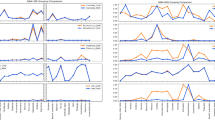Abstract
Models of the microbial food web have generally used compartments aggregated by general body size and gross taxonomy. It has been assumed that these also reflect guilds or holons. Generally, results of simulation or analysis based on this structure have been reasonably well validated. Herein I summarize why the aggregations may be justified and what may be learned from disaggregation.
Similar content being viewed by others
References
Allen TFH, Starr TB (1982) Hierarchy: perspectives for ecological complexity. University of Chicago Press, Chicago
Baird D, Ulanowicz RE (1989) The seasonal dynamics of the Chesapeake Bay ecosystem. Ecol Monogr 59:329–364
Burns TP, Higashi M, Wainwright SC, Patten BC (1991) Trophic unfolding of a continental shelf energy-flow network. Ecol Modelling 55:1–26
Christian RR, Wetzel RL (1991) Synergism between research and simulation models of estuarine microbial food webs. Microb Ecol 22:111–125
Cohen JE, Briand F, Newman CM (1990) Community food webs: data and theory. Springer-Verlag, Berlin.
Cohen JE, 23 others (1993) Improving food webs. Ecology 74:252–258
DeLong EF, Franks DG, Allredge AL (1993) Phylogenetic diversity of aggregated-attached vs. free-living bacterial assemblages. Limnol Oceanogr 38:924–934
Ducklow HW (1993) Modeling the microbial foodweb. Microb Ecol 28:
Gaedke U (1992) Identifying ecosystem properties: a case study using plankton biomass size distributions. Ecol Modelling 63:277–298
Martinez ND (1991) Artifacts or attributes? Effects of resolution on the Little Rock Lake food web. Ecol Monogr 61:367–392
Pace ML, Glasser JE, Pomeroy LR (1984) A simulation analysis of continental shelf food webs. Mar Biol 82:47–63
Pierce RW, Turner JT (1992) Ecology of planktonic ciliates in marine food webs. Aquat Sci 6:139–181
Pomeroy LR, Wiebe WJ (1988) Energetics of microbial food webs. Hydrobiologia 159:7–18
Sheldon RW, Prakash A, Sutcliffe WH (1972) The size distribution of particles in the ocean. Limnol Oceanogr 17:327–340
Simon M (1988) Growth characteristics of small and large free-living and attached bacteria in Lake Constance. Microb Ecol 15:151–163
Stocker DK, Capuzzo JMcD (1990) Predation on protozoa: its importance to zooplankton. J Plankton Res 12:891–908
Wetzel RL, Christian RR (1984) Model studies on the interactions among carbon substrates, bacteria, and consumers in a salt marsh estuary. Bull Mar Sci 35:601–614
Wright RT, Coffin RB (1993) The microbial loop in a saltmarsh estuary: steady state vs. constant change. (Paper presented at Microbial Loop Symposium)
Author information
Authors and Affiliations
Rights and permissions
About this article
Cite this article
Christian, R.R. Aggregation and disaggregation of microbial food webs. Microb Ecol 28, 327–329 (1994). https://doi.org/10.1007/BF00166824
Issue Date:
DOI: https://doi.org/10.1007/BF00166824




